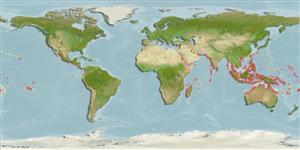Preferred temperature (Ref.
123201): 25.5 - 29.3, mean 28.5 °C (based on 3131 cells).
Phylogenetic diversity index (Ref.
82804): PD
50 = 0.5010 [Uniqueness, from 0.5 = low to 2.0 = high].
Bayesian length-weight: a=0.01096 (0.00647 - 0.01859), b=3.05 (2.91 - 3.19), in cm total length, based on LWR estimates for this species & (Sub)family-body (Ref.
93245).
Trophic level (Ref.
69278): 4.3 ±0.26 se; based on food items.
Widerstandsfähigkeit (Ref.
120179): hoch, Verdopplung der Population dauert weniger als 15 Monate. (Preliminary K or Fecundity.).
Fishing Vulnerability (Ref.
59153): Low vulnerability (10 of 100).
Nutrients (Ref.
124155): Calcium = 117 [60, 247] mg/100g; Iron = 0.778 [0.388, 1.423] mg/100g; Protein = 18.9 [17.0, 20.6] %; Omega3 = 0.138 [0.061, 0.267] g/100g; Selenium = 14.6 [7.1, 31.0] μg/100g; VitaminA = 134 [36, 471] μg/100g; Zinc = 2.17 [1.43, 3.24] mg/100g (wet weight);
